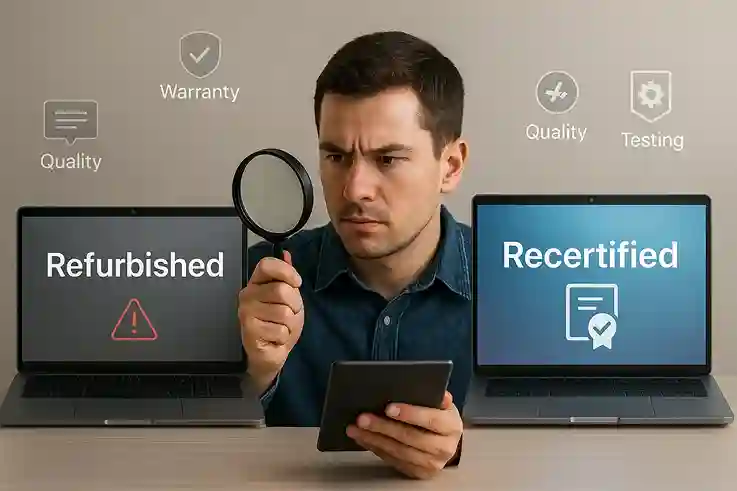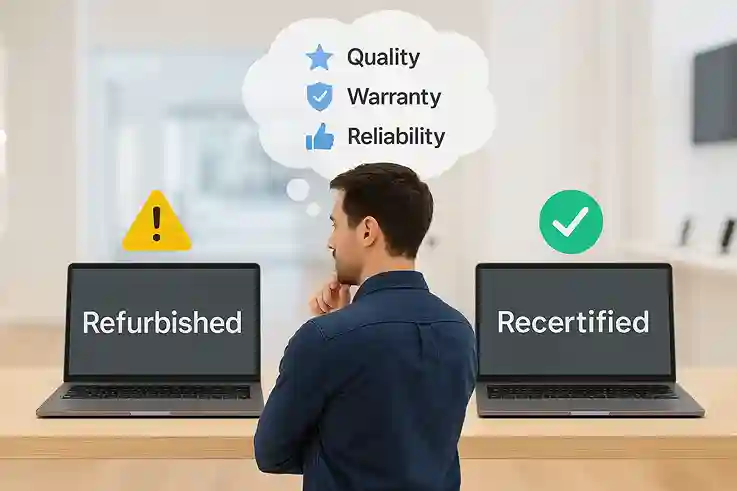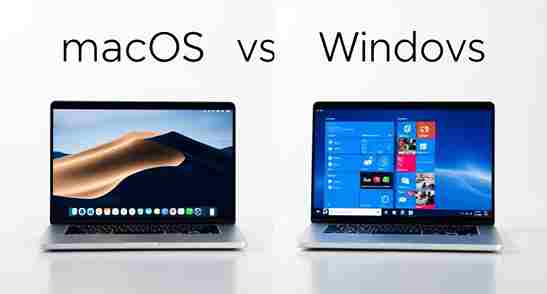Refurbished vs Recertified describes two common labels that buyers often see but rarely understand. Both terms suggest that a product has been returned, tested, and resold, yet the paths they take are very different. Refurbished items may come from customer returns, damaged goods, or open-box products that retailers fix before selling again. Recertified products, however, usually go back to the manufacturer for strict testing and verification. Because the words sound so similar, many buyers assume they mean the same thing. This blog clears up the confusion and helps you avoid costly mistakes when shopping for electronics.
“Refurbished vs recertified can mean the difference between a deal and a mistake.”
What Does Refurbished Mean?
Refurbished products are items that have been used before but are repaired and resold at a lower price. The process usually involves cleaning, fixing defects, and replacing faulty parts. However, the depth of testing can vary depending on the seller.

These items often come from customer returns, damaged shipments, or used goods traded in by previous owners. Retailers or third-party vendors inspect them before putting them back on the market. Sometimes the repairs are thorough, but other times they may be minimal.
The main risk is inconsistency. Not all refurbished items meet the same standards, especially when sellers cut corners. Warranties may be short or even missing, which leaves buyers with little protection. This uncertainty makes refurbished products cheaper but also less reliable than recertified ones. Understanding these risks is crucial so you can decide whether the savings outweigh the potential problems.
What Does Recertified Mean?
Recertified products are items that go back to the original manufacturer for inspection, testing, and approval before resale. Unlike refurbished goods, which may be handled by third-party sellers, recertified items pass through the company that built them. This key difference gives buyers more confidence in quality and safety.
Manufacturers usually apply stricter testing standards, often bringing the product close to “like-new” condition. Components are checked, repaired if needed, and verified against factory guidelines. Many brands also update software, replace packaging, and include all standard accessories.
Another important point is the guarantee. Recertified items usually come with a clear warranty directly from the manufacturer. That coverage provides better protection if the product fails later. Because of this, recertified products often cost slightly more than refurbished ones, but the added reliability makes them a safer choice. The result is a product that feels much closer to new.
Refurbished vs Recertified: Key Differences
When comparing Refurbished vs Recertified, the differences stand out in warranty, testing, resale value, and reliability. Many sellers misuse the terms to make products sound more appealing, which adds to the confusion for buyers.
Warranty
Refurbished products usually come with short or limited warranties, and sometimes they offer no coverage at all. This lack of protection makes them riskier for long-term use. Recertified products, on the other hand, typically include a warranty backed by the original manufacturer. That coverage can range from several months to a full year, depending on the brand. For buyers, this manufacturer-backed guarantee provides stronger protection and greater confidence compared to refurbished items.

Testing Process
Refurbished items are often tested by retailers or independent third parties, and the level of inspection can vary widely. Some sellers only perform basic checks, while others may replace key parts. Because there is no universal standard, quality can be inconsistent. Recertified items, by contrast, go through strict factory-level inspections. The original manufacturer tests each component, updates software if needed, and verifies performance to brand standards, making the product far more reliable.
Resale Value
Refurbished items often lose value quickly because buyers are uncertain about their quality and long-term performance. Since testing standards vary, resale markets treat these products as less reliable. Even if the item works well, its value drops faster compared to newer models. Recertified items, however, hold their value longer. They are inspected by the original manufacturer, meet stricter standards, and are closer to new condition, which makes them more attractive in resale markets.
Reliability
Refurbished items can sometimes perform well, but their reliability depends heavily on who carried out the repairs. A product fixed by a skilled technician may last for years, while one repaired with minimal effort could fail quickly. This inconsistency makes refurbished items less predictable. Recertified products, however, are overseen by the original manufacturer. Strict testing and factory standards ensure consistent quality, which makes them far more reliable for long-term use compared to refurbished items.
Comparison Table: Refurbished vs Recertified
| Feature | Refurbished | Recertified |
|---|---|---|
| Warranty | Short or limited coverage | Manufacturer-backed coverage |
| Testing | Varies by seller, may be minimal | Strict factory testing and inspection |
| Resale Value | Depreciates quickly | Holds value longer |
| Reliability | Inconsistent quality | Higher reliability, near-new standard |
Why the Right Choice Matters

The Cost of a Wrong Choice
Picking between refurbished vs recertified goes beyond finding the lowest price. Choosing poorly can lead to expensive repairs or complete replacements. Refurbished items often seem like bargains, but without strong warranties, even a small breakdown can erase the savings. A failed laptop battery or phone screen replacement may end up costing more than buying new. Recertified products, though pricier, usually include warranties that protect you and deliver better long-term value.
Real-World Example
Imagine purchasing a refurbished laptop for school. At first, it runs smoothly, but within weeks the motherboard fails. The repair bill ends up costing more than the discount you gained. The same risk exists with refurbished phones, where a weak battery or cracked screen repair can quickly erase any savings. Without reliable warranties, these products may turn from “great deals” into costly mistakes, showing why understanding refurbished vs recertified really matters.
Why Knowledge Matters
Recertified products go through strict testing by the original manufacturer, which greatly reduces the risk of hidden defects. This added reliability, combined with warranty protection, often saves buyers money in the long run. While the upfront cost may be higher, the peace of mind and long-term value make it worthwhile. Understanding the difference between refurbished vs recertified allows you to make smarter choices and avoid expensive mistakes when shopping for electronics.
Pros and Cons of Refurbished Items
Cost Savings Potential
One of the biggest advantages of refurbished items is their lower price. They are often significantly cheaper than buying new or even recertified versions. For budget-conscious buyers, this can make high-end electronics—such as laptops, tablets, or smartphones—far more affordable. Refurbished items open the door to technology that might otherwise be out of reach. However, while the savings are appealing, they do come with trade-offs in warranty protection and long-term reliability.
Variety and Availability
Refurbished products often come from customer returns, overstock, or discontinued models, which makes them widely available in the market. They can be found in a variety of conditions and across many different price ranges. For shoppers, this means access to older models that may no longer be sold new, often at a steep discount. The wide selection adds to the appeal, especially for buyers looking for specific features or budget-friendly options.
Risks of Quality and Warranty
The biggest drawback is uncertainty. Refurbished items may carry only short warranties, and sometimes none at all. Quality depends on how thoroughly the product was repaired and tested, which can vary between sellers. While some items perform well, others may fail quickly. Buyers face the risk of inconsistent reliability, making refurbished products a gamble compared to recertified options.
Pros and Cons of Recertified Items
Reliability from Manufacturer Testing
Recertified products undergo testing directly by the original manufacturer, which guarantees stricter quality control than third-party refurbished items. Every component is carefully inspected, repaired if necessary, and approved to meet factory standards. Many brands also restore software, replace accessories, and repackage the product. This detailed process ensures consistent performance and durability. As a result, recertified products are far more reliable than refurbished ones, giving buyers greater peace of mind and long-term confidence in their purchase.
Longer Warranties in Many Cases
A major benefit of recertified items is the stronger warranty coverage they usually include. Unlike refurbished products, which may only have short or limited protection, recertified items often carry manufacturer-backed warranties lasting several months to a full year. This added layer of security reassures buyers that any hidden issues will be handled by the brand itself. The extended coverage not only protects the purchase but also builds confidence in the product’s long-term reliability.
Higher Cost but More Peace of Mind
Recertified items often come with a higher price tag compared to refurbished versions, but the added cost reflects greater reliability. For many buyers, paying a bit more upfront can actually save money over time by reducing the risk of expensive repairs or replacements. The combination of thorough manufacturer testing and solid warranty coverage makes these products a safer long-term investment. The peace of mind that comes with this added protection often outweighs the initial expense.
Refurbished vs Recertified: Pros and Cons
| Aspect | Refurbished Items | Recertified Items |
|---|---|---|
| Reliability | Varies by seller, inconsistent repairs | Manufacturer-tested, consistent quality |
| Warranty | Short, limited, or sometimes none | Longer, manufacturer-backed coverage |
| Cost | Lower upfront price, big savings | Higher cost but safer investment |
| Availability | Widely available, includes discontinued models | Limited supply, depends on manufacturer stock |
| Quality Control | Depends on third-party testing | Strict factory-level standards |
| Peace of Mind | Less certainty, more risk | Greater confidence, near-new reliability |
How to Spot Genuine Recertified Products
Look for Manufacturer Seals
A genuine recertified product should always carry an official manufacturer seal or certification label. This mark signals that the product was inspected, repaired if necessary, and tested by the original company. It’s the clearest sign of authenticity because only manufacturers can issue it. If you see a product advertised as “recertified” but without a seal, be cautious. It may only be refurbished by a third-party seller trying to market it as something better.
Check Return Policies
Recertified items usually come with strong return policies that reflect the manufacturer’s confidence in quality. If a seller does not offer returns or only allows a very short period, that’s a red flag. Most genuine recertified products provide at least a 14–30 day return window, often longer. This gives buyers peace of mind and ensures there’s recourse if something goes wrong. Always review the policy before completing a purchase.
Verify Coverage Length
One of the most important differences between refurbished vs recertified products is warranty protection. Recertified products almost always include manufacturer-backed coverage, typically lasting several months to a full year. Before buying, confirm the warranty details directly on the manufacturer’s website or with customer support. If the product only has a 30-day store warranty or vague coverage, it may not be truly recertified. A clear, manufacturer-issued warranty is essential for long-term confidence.
Here’s the link to Apple’s U.S. certified refurbished store: Apple Certified Refurbished Products – US
Tips for Safe Buying Decisions
Always Compare Seller Policies
Before buying, always review a seller’s policies closely. Reliable sellers are clear about warranties, return windows, and testing standards. If the information feels vague or incomplete, consider it a warning sign. Transparency is key, and skipping this step can lead to costly mistakes later.
Register Your Product with the Brand
After purchase, register your product on the manufacturer’s website. This step activates warranty coverage, guarantees access to essential updates, and speeds up customer support if problems occur. Registration also creates an official record with the brand, giving you stronger protection and peace of mind throughout the product’s lifespan.
Keep Purchase Receipts for Future Claims
Receipts or order confirmations act as proof of purchase and are required for warranty service or refunds. Keep both digital and paper copies stored safely. Without them, claims may be rejected, leaving you without protection. Organized records ensure smoother support if issues arise later.
Buy Only from Authorized Sellers
Always verify if the seller is officially authorized by the manufacturer. Authorized sellers are less likely to mislabel refurbished vs recertified products and are more reliable when it comes to honoring brand-backed warranties. This step greatly reduces risk and ensures you’re getting genuine, protected items.
Read Product Descriptions Carefully
Always read product descriptions carefully. Genuine listings often state “manufacturer recertified” or “factory recertified.” If the wording feels vague, unclear, or avoids mentioning the manufacturer, treat it as a warning sign. In many cases, such products are only refurbished, not recertified, which changes their reliability and warranty.
FAQs Refurbished vs Recertified
Conclusion
Understanding the difference between refurbished vs recertified can save you money and frustration. Refurbished items are attractive for their lower prices and wide availability, but they come with higher risks, shorter warranties, and inconsistent quality. Recertified products, on the other hand, undergo strict manufacturer testing and typically include stronger warranty protection, making them a safer investment even at a slightly higher cost.
The right choice depends on your needs. If budget is your top priority and you’re willing to take some risk, refurbished may work. But if you value reliability and peace of mind, recertified is often the smarter pick.
Have you ever bought refurbished or recertified products? Did the experience match your expectations?
Share your story in the comments below—we’d love to hear how you navigated the decision and what you learned along the way.

Amina Pierce is a tech-savvy blogger with a specialty in electronics, where she shares practical insights on gadgets, innovations, and the latest trends shaping our digital world. With a strong interest in how technology impacts everyday life, she breaks down complex topics into clear, easy-to-understand articles for readers of all backgrounds. While electronics is her main focus, Amina also enjoys writing on a variety of other subjects, including lifestyle, travel, and personal growth, making her content both diverse and engaging.
Outside of blogging, Amina loves tinkering with new devices, exploring smart home solutions, and capturing her experiences through travel photography. Her blend of technical knowledge and approachable style makes her a trusted source of information and inspiration.


